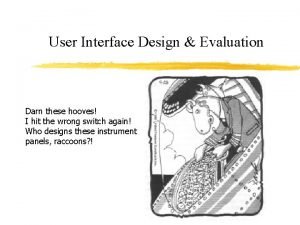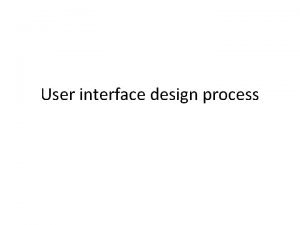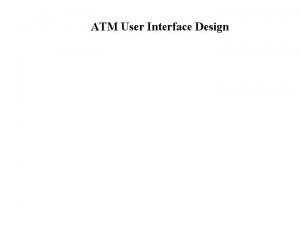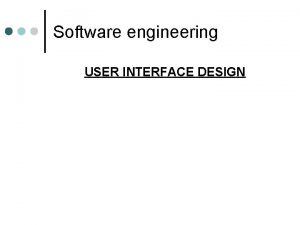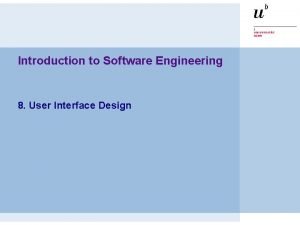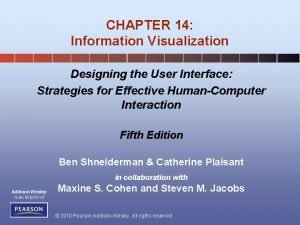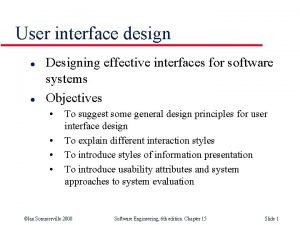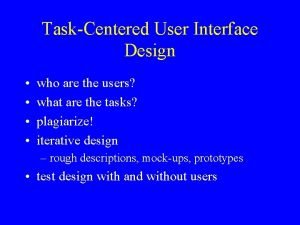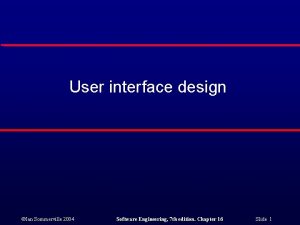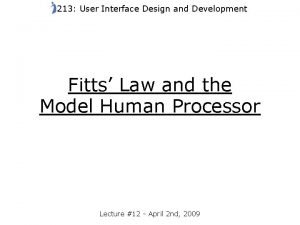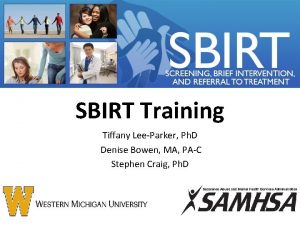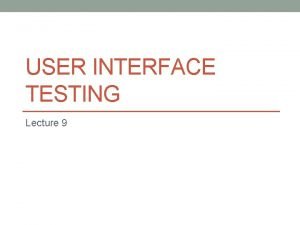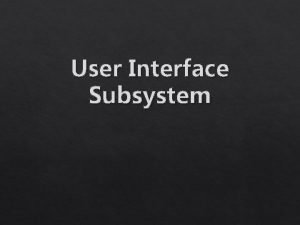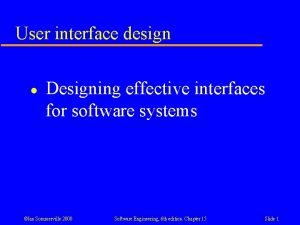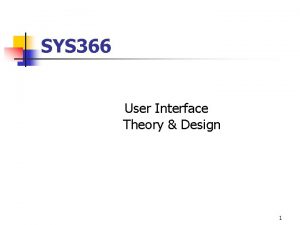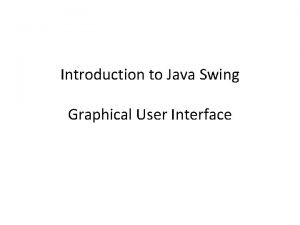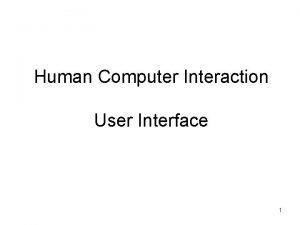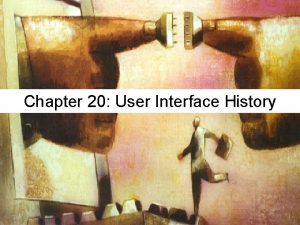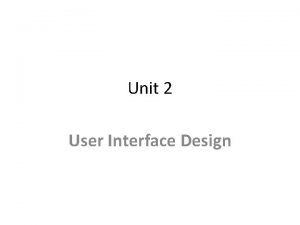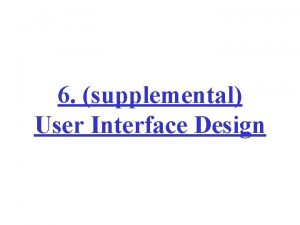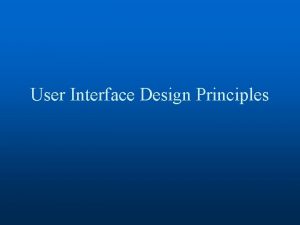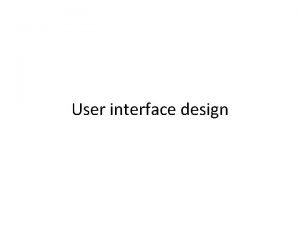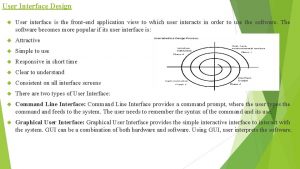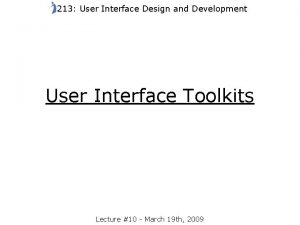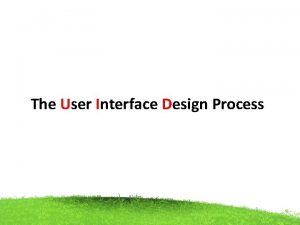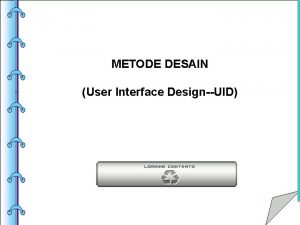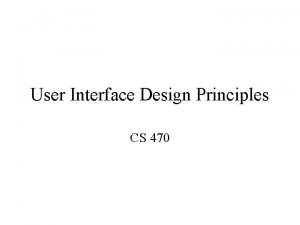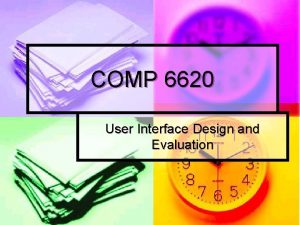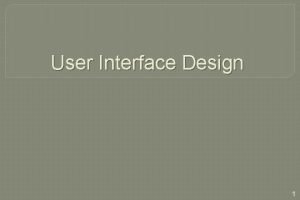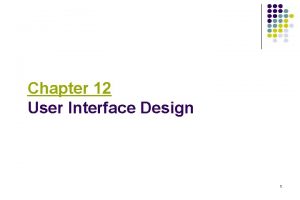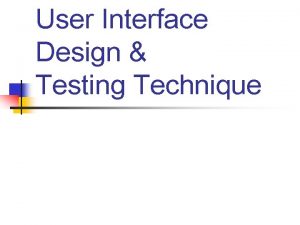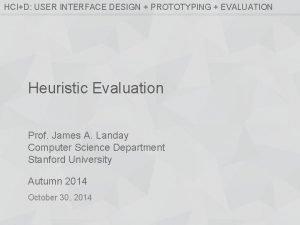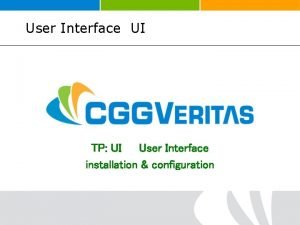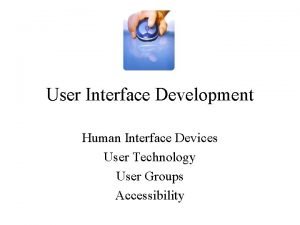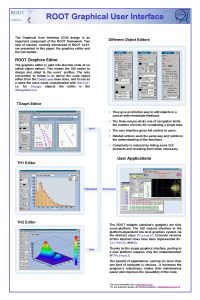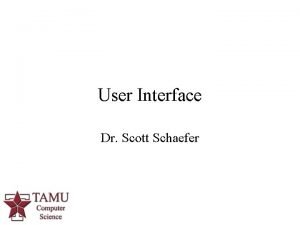User Interface Design Evaluation Darn these hooves I


















































- Slides: 50

User Interface Design & Evaluation Darn these hooves! I hit the wrong switch again! Who designs these instrument panels, raccoons? !

Two Challenges of UI Create user interface software that you can maintain well, that is truly object-oriented, and that allows changes to parts without impacting everything Create user interfaces that people can actually use The latter is much harder and is what we’ll discuss today Briefly! No substitute for a real HCI class Fall 2004 Copyright 2000, Mark Guzdial 2

Goal: Usability Combination of Ease of learning High speed of user task performance Low user error rate Subjective user satisfaction User retention over time Fall 2004 Copyright 2000, Mark Guzdial 3

UI Design: The Good… Fall 2004 Copyright 2000, Mark Guzdial 4

The Bad… Fall 2004 Copyright 2000, Mark Guzdial 5

The Bad… Fall 2004 Copyright 2000, Mark Guzdial 6

The Ugly… Fall 2004 Copyright 2000, Mark Guzdial 7

The (really) Ugly… Fall 2004 Copyright 2000, Mark Guzdial 8

Outline Design Know thy users Principles User Centered Design: A UI Design Process User Testing / Evaluation Testing without users Testing with groups Fall 2004 Copyright 2000, Mark Guzdial 9

Know Thy Users! (For they are not you) Physical & cognitive abilities (& special needs) Personality & culture Knowledge & skills Motivation Two Fatal Mistakes: Assume all users are alike Assume all users are like the designer You Are Here Fall 2004 Copyright 2000, Mark Guzdial 10

Designers vs. Users “My friends and I can use it, so it must be easy to use” The user may not be anything like you Making an interface that works for you may not work at all for your users Most users are not programmers Most users have expertise, but not in computers You probably don’t have their expertise! They may think about things very different than you! Fall 2004 Copyright 2000, Mark Guzdial 11

Design Principles Intended to prevent many bad designs before they begin Guidelines based on previous designs, experimental findings Rules can all be “broken” (but usually in order to satisfy another principle) These are only a subset… Fall 2004 Copyright 2000, Mark Guzdial 12

Predictability I think that this action will do…. Operation visibility Can see avail. actions e. g. menus vs. command shell grayed menu items Fall 2004 Copyright 2000, Mark Guzdial 13

Familiarity Does UI task leverage existing real-world or domain knowledge? Really relevant to first impressions Use of metaphors Potential pitfalls Are there limitations on familiarity? Fall 2004 Copyright 2000, Mark Guzdial 14

Generalizability Can knowledge of one system/UI be extended to other similar ones? Example: cut & paste in different applications Does knowledge of one aspect of a UI apply to rest of the UI? Aid: UI Developers guidelines Fall 2004 Copyright 2000, Mark Guzdial 15

Observability Can user determine internal state of system from what she perceives? Problems with Modes Browsability Explore current state (without changing it) Reachability Navigate through observable states Persistence How long does observable state persist? Fall 2004 Copyright 2000, Mark Guzdial 16

Recoverability Ability to take corrective action upon recognizing error Difficulty of recovery procedure should relate to difficulty of original task Forward recovery Ability to fix when we can’t undo Backward recovery Undo previous error(s) Fall 2004 Copyright 2000, Mark Guzdial 17

Responsiveness Users perception of rate of communication with system Response time Time for system to respond in some way to user action(s) bandwidth vs. latency Fall 2004 Copyright 2000, Mark Guzdial 18

Outline Design Know thy users Principles User Centered Design: A Design Process User Testing / Evaluation Testing without users Testing with groups Fall 2004 Copyright 2000, Mark Guzdial 19

User-Centered Design A way to force yourself to identify and consider the relevant human factors in your design Helps reduce the number of decisions made out of the blue, and helps focus design activities Helps document and defend decisions that may be reviewed later Fall 2004 Copyright 2000, Mark Guzdial 20

The Tao of UCD DESIGN IMPLEMENT USE & EVALUATE Fall 2004 Copyright 2000, Mark Guzdial 21

UCD: 9 Step Overview 1. 2. 3. 4. 5. 6. 7. 8. 9. Define the Context Describe the User Task Analysis Function Allocation System Layout / Basic Design Mockups & Prototypes Usability Testing Iterative Test & Redesign Updates & Maintenance Fall 2004 Copyright 2000, Mark Guzdial 22

Design Implications At each stage, consider how the details of your discovery process affect your design Fact Implications Users 16 -80 yrs Range of text sizes Range of grip strength Some French speakers Multilingual interface Astronaut users Extensive training available Military context Aesthetics less of an issue Ruggedness is critical Fall 2004 Copyright 2000, Mark Guzdial 23

1. Define the Context: the “type” of uses, applications Life critical systems, applications Industrial, commercial, military, scientific, consumer Office, home, entertainment Exploratory, creative, cooperative Market Customer (not the same as the User) Fall 2004 Copyright 2000, Mark Guzdial 24

2. Describe the User Physical attributes (age, gender, size, reach, visual angles, etc…) Physical work places (table height, sound levels, lighting, software version…) Perceptual abilities (hearing, vision, heat sensitivity…) Cognitive abilities (memory span, reading level, musical training, math…) Personality and social traits (likes, dislikes, preferences, patience…) Cultural and international diversity (languages, dialog box flow, symbols…) Special populations, (dis)abilities Fall 2004 Copyright 2000, Mark Guzdial 25

3. Task Analysis Talk to and observe users (NOT customers) doing what they do List each and every TASK Break tasks down into STEPS ABSTRACT into standard tasks (monitor, diagnose, predict, control, inspect, transmit, receive, decide, calculate, store, choose, operate, etc. ) Fall 2004 Copyright 2000, Mark Guzdial 26

4. Function Allocation Consider the whole system! Decide who or what is best suited to perform each task (or each step) e. g. , system remembers login id, and reminds the user, but user remembers the password Base this on knowledge of system hardware, software, human users’ abilities, culture, communications protocols, privacy, etc. Allocation constraints: Effectiveness; Cognitive/affective; Cost; Mandatory Fall 2004 Copyright 2000, Mark Guzdial 27

5. System Layout / Basic Design Summary of the components and their basic design Cross-check with any Requirements Documents; Human Factors refs; Hardware specs; Budgets; Laws (ADA); etc. Ensure that the system will support the design and comply with constraints (Verification and Validation, in the language of software engineering) Fall 2004 Copyright 2000, Mark Guzdial 28

6. Mockups & Prototypes “Informed Brainstorming” RAPIDLY mock up the user interfaces for testing with real people Pen and paper or whiteboard to start Iterate, iterate!! Increasingly functional & veridical List audio & visual details at same levels of detail in the prototypes (i. e. don’t forget either of them) Fall 2004 Copyright 2000, Mark Guzdial 29

7. Usability Testing Get real (or representative) users to do what they do, using the prototypes Subjective and objective feedback. Sometimes users “want” features that actually yield poor performance Video tape, lots of notes Be rigorous wherever possible (stats, etc. ) Feedback into the iterative evaluation & redesign of the system “Discount” usability testing can be very effective, using fewer subjects, more rapid results Fall 2004 Copyright 2000, Mark Guzdial 30

8. Iterative Test & Redesign Repeat cycles of testing and reworking the system, subject to cost/time constraints Plan for several versions during development Fall 2004 Copyright 2000, Mark Guzdial 31

9. Updates & Maintenance In-the-field feedback, user data, logs, surveys, etc. Analyze and make iterative redesign/test recommendations Updates and maintenance plan as part of the design! (design it so it can be fixed or updated) Fall 2004 Copyright 2000, Mark Guzdial 32

Outline Design Know thy users Principles User Centered Design: A Design Process User Testing / Evaluation Testing without users Testing with groups Fall 2004 Copyright 2000, Mark Guzdial 33

How do you decide between interface alternatives? Clock. Morph Ch 5 Clock. UI Fall 2004 Copyright 2000, Mark Guzdial 34

User Testing / Evaluation How to choose between interface alternatives, improve an existing design Both subjective and objective metrics Some things we can measure Time to learn Speed of performance Rate of errors by user Retention over time Subjective satisfaction Fall 2004 Copyright 2000, Mark Guzdial 35

Evaluating Without Users Heuristic evaluation Carefully analyzing a user interface in terms of a set of standard questions or issues E. g. , “Is the necessary knowledge always visible? ” Review guidelines (consistency) Using a standard for UI guidelines (e. g. , Apple, IBM, etc. ) determine if meets guidelines E. g. , “Is the Cancel button always in the right place? ” Cognitive walkthrough Will the system make sense to the user? Fall 2004 Copyright 2000, Mark Guzdial 36

Sample Useful Heuristics Can the user figure out their current state? Is everything that the user needs to know about visible on the screen? Is the language on the screen in the language of the user (not the programmer)? Is help available? Are error messages useful? Fall 2004 Copyright 2000, Mark Guzdial 37

UI Manuals GNOME: http: //developer. gnome. org/projects/gup/hig/ Apple: http: //developer. apple. com/ue/ Fall 2004 Copyright 2000, Mark Guzdial 38

Cognitive Walkthrough Start out with a description of the system, the users’ goals, and a process description for a useful task Walk the process description asking at each step: Does this make sense for this user? Will they understand it? Will the user be able to figure out what to do next? Will the users be able to understand the feedback that they get? If something goes wrong, can they tell? Can they figure out how to fix it? Fall 2004 Copyright 2000, Mark Guzdial 39

You try! user description, heuristics, scenarios Fall 2004 Copyright 2000, Mark Guzdial 40

Evaluating with Users In the end, you can never really be sure that your interface works until you face the users It’s always better (less expensive!) to identify and correct errors earlier rather than later, so pre-user methods are useful But real users have ways of interpreting things, doing things, and breaking things that you might never expect. “Know they users for they are not you!” Examples Fall 2004 Copyright 2000, Mark Guzdial 41

Deciding How to Evaluate with Users What do you want to learn? Goal: How can I improve my UI? Observation Questionnaires Goal: Is my software better than X (X=competitor’s software, doing it by hand)? You need enough users to conduct a real experiment You need an experiment and control group Have them perform some standard set of tasks and measure time, accuracy, number of errors, etc. Beyond the scope of this lecture Fall 2004 Copyright 2000, Mark Guzdial 42

Observing Users Yogi Berra: “You can see a lot just by watching!” Observation can buy you a lot But is usually not enough: “Why are you doing that same error-generating thing over-and-over? !? ” Think-alouds Get the users to say out loud what they’re seeing, what they’re doing, and why they’re doing it while they’re doing it Important that designers don’t interfere! “I’m sorry I made this so hard to use, but…” Fall 2004 Copyright 2000, Mark Guzdial 43

User Testing / Evaluation is Actually a Misnomer You test / evaluate software, not users Tell the user you need their help to make the software better Users are inherently nice – they don’t want to hurt your feelings by pointing out flaws You’ll make them more comfortable Encourages more exploration, more freedom to critique, and more openness Fall 2004 Copyright 2000, Mark Guzdial 44

Questionnaires Can’t always observe Natural use is probably not in a laboratory setting Your software may only work with lots of people using May want to state something more rigorously Alternative: Questionnaire Phrase the questions to get at what you want—and what you don’t know yet Best 3, Worst 3 Fall 2004 Copyright 2000, Mark Guzdial 45

Designing questionnaires Multiple choice and scalar questions (“on a scale of 1 to 5 where…”) are easier to analyze Ask the same thing in multiple ways Determine inconsistencies that may identify confusion May find that there are subtleties you were missing earlier Ask for volunteers for follow-up interviews Fall 2004 Copyright 2000, Mark Guzdial 46

Evaluating Groupware With the Web growth, more-and-more software designed for use in groups Consider an auction site as an example Groupware is especially hard to evaluate Users may be distributed Different users have different roles: Buyers, sellers, brokers, admins Success may depend on context, culture Often, goals more than just usability E. g. social agenda as well as usability agenda Fall 2004 Copyright 2000, Mark Guzdial 47

Different Roles / Needs You may not have one type of user There may be different roles to account for Even for the same user, the role may switch In communities, different roles may emerge that had not been anticipated Fall 2004 Copyright 2000, Mark Guzdial 48

Logging If you can’t observe, get the software to do it for you Record all the users’ actions in a file (with permission!) Analyze after the fact What errors occurred often? What were the common activities? Problem: can only gather what they did, not why they did it Fall 2004 Copyright 2000, Mark Guzdial 49

Summary Design Know thy users Principles User Centered Design: A Design Process User Testing / Evaluation Testing without users Testing with groups Fall 2004 Copyright 2000, Mark Guzdial 50
 User interface design and evaluation
User interface design and evaluation User interface design in system analysis and design
User interface design in system analysis and design What are the inputs and outputs of system design?
What are the inputs and outputs of system design? Principles of input design
Principles of input design User interface design cycle
User interface design cycle User interface in software engineering
User interface in software engineering User interface analysis and design
User interface analysis and design Principles of user interface design
Principles of user interface design User interface design and implementation
User interface design and implementation Atm user interface
Atm user interface Types of user interface in software engineering
Types of user interface in software engineering User interface design in software engineering
User interface design in software engineering Python user interface design
Python user interface design Visualization in user interface design
Visualization in user interface design Recoverability in user interface design
Recoverability in user interface design User interface design process in software engineering
User interface design process in software engineering Task centered user interface design
Task centered user interface design User interface design process in software engineering
User interface design process in software engineering Labview user interface design examples
Labview user interface design examples User interface design process in software engineering
User interface design process in software engineering Fitts law user interface design
Fitts law user interface design Change talk worksheet
Change talk worksheet Darn cat motivational interviewing
Darn cat motivational interviewing Darn cat motivational interviewing
Darn cat motivational interviewing Darn cat motivational interviewing
Darn cat motivational interviewing Darn cat motivational interviewing
Darn cat motivational interviewing The least offensive play in the whole darn world
The least offensive play in the whole darn world Interface in interface java
Interface in interface java Fluidity in hci
Fluidity in hci Industrial interfaces
Industrial interfaces An interface
An interface Yahoo user interface
Yahoo user interface Xml user interface language
Xml user interface language Graphical user interface testing
Graphical user interface testing Komponen user interface
Komponen user interface Enterprise architect deployment diagram
Enterprise architect deployment diagram User interface importance
User interface importance Touch screen technology seminar
Touch screen technology seminar Web based interface
Web based interface Tangible user interface examples
Tangible user interface examples User interface theory
User interface theory Multiple document interface
Multiple document interface Uas imk
Uas imk Introduction of gui
Introduction of gui Java graphical user interface
Java graphical user interface Hci user interface
Hci user interface Graphical user interface history
Graphical user interface history User interface feedback
User interface feedback Interface component
Interface component Characteristics of graphical user interface in hci
Characteristics of graphical user interface in hci User interface history
User interface history
